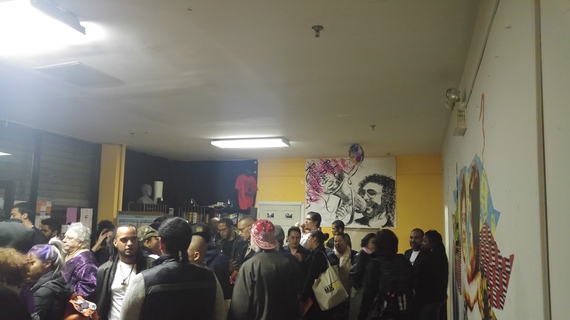(image: AqualungBX/Flickr)
To outsiders, the South Bronx has long had a reputation for crushing poverty, violent crime, and widespread arson. But to the largely Black and Latino longtime residents, the South Bronx is testament to the ability of communities to survive and thrive in the face of decades of governmental neglect, persistent economic inequality, and built-in racist planning. Today, the borough of the Bronx is the site of a contentious battle around space, racial justice and economic fairness.
Over the last decade, the Bronx has seen a slow trickle of gentrification as transplanted renters and buyers alike have tried to take advantage of lower property values. To many, gentrification is most associated with the changing character of a district, the arrival of boutique coffee shops, trendy restaurants, and franchises that previously avoided poorer neighborhoods. But gentrification is in fact much more than that, it refers to the arrival of wealthier residents, usually with no ties to to the existing communities. The demand for housing, spurred by the influx of people willing and able to pay more, leads to escalating rents and drastic changes in a neighborhood's makeup across economic, cultural, and often racial lines. The South Bronx for example, is approximately 90% Black and Latino and it is these communities that have faced decades of inequality and that will face the brunt of gentrification's violent side effects.
The consequences for many longtime residents are severe; as they struggle to hold on to neighborhoods they have long called home, they may find themselves unable to afford rising rents and saddled with the financial burdens of relocating. Those that leave are often forced out under unseemly circumstances such as eviction by landlords using illegal and exploitative practices to vacate apartments. It can mean the closing of a long-established neighborhood restaurant to make way for a frozen yogurt shop, or the eviction of an elderly resident to make way for younger tenants willing to pay double her rent.
Gentrification is also inextricably linked to real estate development, where developers purchase large swaths of land, often holding on for years as they build luxury housing and invite high-end businesses. In most cases, the developers work in conjunction with local politicians, many of whom they have donated to, to help expedite the process. This is precisely what is happening in the South Bronx, where developers like the Somerset Partners LLC and the Chetrit Group have spent hundreds of millions of dollars, purchasing buildings and lots in order to build luxury developments as they aim to rebrand the South Bronx as "the Piano District," hearkening back to large role the neighborhood played in producing pianos in the early 1900s.
According to Architects and Artisans, Somerset Partners founder Keith Rubenstein claims that the development will lead to widespread improvements for the community, specifically as "...a wave of business that follows that will be enormous, with offices and cultural aspects - the museums and schools will just get better." Aside from his financial interests, Rubenstein's actual concern with the well-being of the existing communities is questionable after The New York Times reported that he helped organized a party and pop up art show called "Macabre Suite." The show has been accused of ridiculing and exploiting the Bronx's history with art installations including a bullet-riddled car and garbage cans burning with fires, all while the event's wealthy celebrity guests enjoyed top shelf liquors and took selfies.
Some local politicians, like Bronx Borough President Ruben Diaz Jr., who attended the party, support the development as something that will uplift the borough's current inhabitants. Still, lifelong Bronx resident and founder and editor of the blog Welcome2TheBronx, Ed Garcia Conde, has been documenting and writing on the recent happenings. He recently pointed out that the Borough President has received campaign donations from Somerset Partners as well as over one hundred and fifty thousand dollars in contributions from other real estate interests.
Fighting Back
Leery of the adverse effects of gentrification and development and distrustful of elected officials, an assortment of community organizers, activists, and concerned residents met on November 7th, at a meeting spearheaded by a collective called Take Back the Bronx. The meeting took place in a community center operated by Mothers on the Move, in the Longwood section of the Bronx.
Approximately 90 people crowded into the small community space to discuss their experiences with gentrification, their concerns about the changes afoot, and their interest in taking a stand against a future of continued unequal development. As Take Back the Bronx members, Tanzeem Shaneela, Lisa Ortega, along with local artist Shellyne Rodriguez moderated the discussion about strategies, people agreed and disagreed on the best direction forward, but a consensus was forming that something had to be done to develop tactics that would combat the impending development boom. Elliot Liu another member of Take Back the Bronx, added that much could be gained and learned from developing solidarity networks to fight gentrification. Ultimately, the organizers and attendees agreed on a number of direct actions to take place in the coming weeks aimed at increasing visibility and public awareness surrounding the issue, as well as the hashtag #TheBronxIsNotForSale.
Reached for a comment a few days after the event, Ms. Shaneela maintains that "[d]espite what developers say, we know that gentrification is not about investing in existing communities. It's about displacing our existing communities because we are working class and of color. This is class war and it is being waged by the rich. But we are ready to fight back so if the developers and the politicians think it will be easy to displace us they should think again."
Why Gentrification, Why Now
America's urban centers are among its most unequal and racially-segregated spaces, fast approaching a degree of disparity only otherwise seen in failed states and other extremely unequal nations. If we are going to talk about inequality, we absolutely must discuss gentrification. More than cupcake shops, froyo-eries and neighborhood "character," gentrification is about real people, their lives, and the space they inhabit. It is about how city policy is swayed by economic interests and the implications this has for of land use. But it is also about the routes kids take home from school, the distance mothers commute to work, and the access communities have to public space. When the topics of gentrification and development are brought up, there is the pervasive and dangerous idea that these two options, often in conjunction, are the only possibilities for poor neighborhoods.
Development is itself an ideologically laced term. It implies that the absence of commercial facilities, retail space, and luxury residences leaves the poor hopeless and without agency. Criticism of gentrification and development should be aimed at the basic assumptions surrounding the distribution of space and resources.
Proponents of gentrification argue that "reinvestment" in low-income or so-called blighted communities benefits current residents. It is actually this politically and economically championed process of gentrification that creates stagnation, or worse, destructive upheaval, not just in the space, but in the lives of low-income city dwellers. Gentrification and development leads to moneyed interests manipulating local government and municipal authorities to change land use in their favor. There can be no trickling down when the river of resources is rerouted. The South Bronx has mattered for a long time, and as a story of economic inequality -- it is central to our national story.


